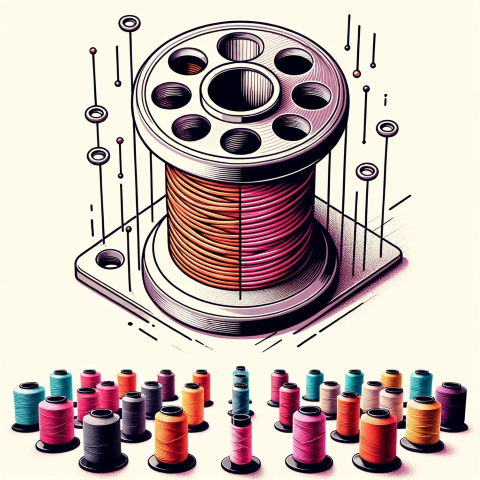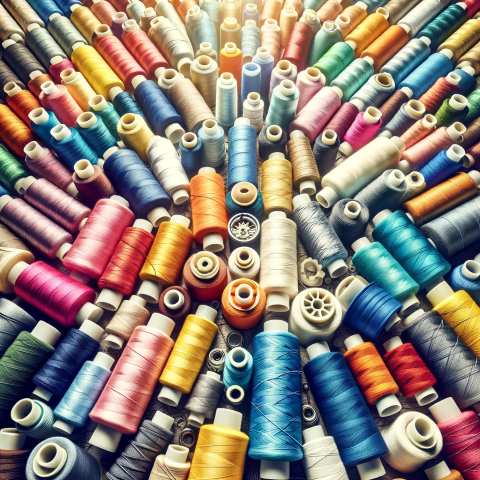Last Updated on: 21-May-2023 (11 months, 3 days ago)
Share on Facebook • Share on Twitter
In the textile industry, a bobbin is a cylindrical or spool-shaped device used to hold and supply thread or yarn during various textile processes such as spinning, weaving, and sewing. Bobbins play a crucial role in the efficient handling and control of thread tension, ensuring smooth and uninterrupted fabric production.
The use of bobbins dates back to ancient times, with early civilizations utilizing rudimentary forms of these devices for textile production. The precise origin of the bobbin is difficult to trace, as various cultures independently developed their own versions. However, the concept of winding thread around a spindle-like object has been present in textile production across different regions and historical periods.
1. Wooden Bobbins: Historically, bobbins were predominantly made of wood. Wooden bobbins offer durability, stability, and smooth thread delivery. Although less common today, they are still used in traditional or specialized textile applications.
2. Metal Bobbins: Metal bobbins, often made of aluminum or steel, are widely used in industrial sewing machines. They provide strength, longevity, and precise thread control, making them ideal for high-speed production environments.
3. Plastic Bobbins: Plastic bobbins are commonly used in domestic sewing machines. They are lightweight, inexpensive, and available in various sizes and styles to accommodate different machines and thread types.
4. Paper/Cardboard Bobbins: Paper or cardboard bobbins are commonly used for small-scale craft projects or temporary stitching. They are disposable and easily accessible, but not suitable for heavy-duty applications.
1. Thread Compatibility: Ensure that the thread you wind onto the bobbin is compatible with the textile process and the material being used. Proper thread selection and tension adjustment are crucial for achieving optimal results.
2. Bobbin Winding: When winding thread onto a bobbin, maintain even tension and avoid overfilling. Overfilled bobbins can lead to thread tangling, machine jams, and inconsistent stitch quality.
3. Bobbin Placement: Insert the bobbin correctly into the bobbin case or shuttle of the sewing machine, following the machine's user manual. Proper placement ensures smooth thread feeding and prevents tangling or uneven stitches.
4. Bobbin Storage: Store bobbins in a clean and organized manner, away from moisture and direct sunlight. This helps maintain their quality and prevents thread contamination or damage.
Top International Users and Manufacturers
Several renowned international companies are recognized for their production and utilization of bobbins in the textile industry. Here are some of the top users and manufacturers:
1. Brother Industries, Ltd.: Brother, a leading sewing machine manufacturer, produces bobbins as part of their comprehensive sewing supplies range. Their bobbins are designed for compatibility with Brother sewing machines and are widely used by sewists worldwide.
2. Singer Corporation: Singer, a prominent sewing machine manufacturer, offers bobbins as part of their accessories line. Singer bobbins are designed for optimal performance on Singer machines and are used by sewing enthusiasts globally.
3. Janome Sewing Machine Co., Ltd.: Janome, a renowned sewing machine manufacturer, produces bobbins that are widely used in their machines. Janome bobbins are known for their quality and compatibility with Janome sewing systems.
4. JUKI Corporation: JUKI, a leading industrial sewing machine manufacturer, produces bobbins designed for high-speed production. Their bobbins are used in various industries, including apparel manufacturing, automotive textiles, and upholstery.
The bobbin is a vital component in textile production, enabling the efficient handling and control of thread or yarn. Throughout history, bobbins have evolved from wooden spools to modern plastic and metal designs, catering to different textile processes and machine types. Proper handling of bobbins, including thread compatibility, correct winding, placement, and storage, ensures smooth fabric production and consistent stitch quality. Prominent manufacturers such as Brother, Singer, Janome, and JUKI supply bobbins to support the global textile industry, contributing to the seamless production of garments, home textiles, and other fabric-based products.
�The technique of permanently joining together two fabrics ? usually a face fabric and lining fabrics of tricot ? into one package. Special adhesives, binders, or thins slices of foam may be used as the marrying agent. Fabrics can also be bonded to ultra-thins slices of foam or other materials and make possible easier handling of fragile cloths such as delicate laces, sheer materials, or lightweight knits, on the cutting tables.
�A cylindrical or slightly tapered barrel, with or without flanges, for holding slubbings, rovings (q.v.) or yarns. (The term is usually qualified to indicate the purpose for which it is used, e.g. ring bobbin, twisting bobbin, spinning bobbin, condensor bobbin, weft bobbin).
Spool or reel that holds the bobbin thread, which helps form stitches on the underside of the fabric. A stitch is formed when the upper thread and bobbin thread are joined together through the sewing process.
Some other terms
Some more terms:
On this page
Add a definition
- The term you want to define
- Its definition in 500 words or less
- Attach an image if necessary.
- Optionally, tell us about yourself in 200 words or less!
Companies for Bobbin:
- Company name
- Company address
- Attach a logo, if necessary.
- Optionally, tell us about yourself in 200 words or less!

